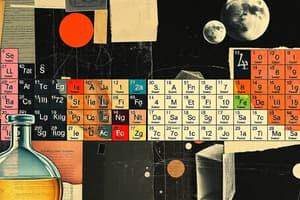Podcast
Questions and Answers
What property generally increases from left to right within a period?
What property generally increases from left to right within a period?
- Electronegativity (correct)
- Ionization energy
- Metallic character
- Atomic radius
Which factor causes the atomic radius to decrease across a period?
Which factor causes the atomic radius to decrease across a period?
- Decrease in effective nuclear charge
- Addition of electrons to outer energy shells (correct)
- Increase in valence electrons
- Filled electron shells increasing
What is the trend for ionization energy as you move down a group on the periodic table?
What is the trend for ionization energy as you move down a group on the periodic table?
- Decreases (correct)
- Remains constant
- Fluctuates
- Increases
Why do metals have metallic character?
Why do metals have metallic character?
How does electronegativity change as you move from left to right across a period?
How does electronegativity change as you move from left to right across a period?
Which property is related to the ease of removing an electron from a neutral atom?
Which property is related to the ease of removing an electron from a neutral atom?
What does the reduction potential of an element indicate?
What does the reduction potential of an element indicate?
Which trend in the periodic table is associated with the formation of positive ions?
Which trend in the periodic table is associated with the formation of positive ions?
What property relates to an element's attraction for electrons in a chemical bond?
What property relates to an element's attraction for electrons in a chemical bond?
Which factor is inversely proportional to the ease of forming positive ions?
Which factor is inversely proportional to the ease of forming positive ions?
Flashcards are hidden until you start studying
Study Notes
Periodic Table and Periodic Properties
Introduction
The periodic table is a graphical arrangement of elements that shows their atomic structure, chemical properties, and trends in behavior across the entire range of known elements. Developed by Russian scientist Dmitri Mendeleev in 1869, the table categorizes like elements together and demonstrates how their properties recur periodically when elements are ordered by increasing atomic mass. This article explores the key concepts related to the periodic table and the trends in various elemental properties, focusing on ionization energy, metallic character, atomic radius, and electronegativity.
Periodic Trends
Periodic trends refer to the consistent patterns in physical and chemical properties displayed by elements in the periodic table. These trends can be explained by the manner in which electrons are distributed across energy levels and how they interact with the nucleus. Some key trends include:
Reduction Potential and Electron Affinity
Reduction potential is related to ionization energy through electron affinity. The smaller the ionization energy, the easier it is to remove an electron from a neutral atom. Similarly, the larger the negative electron affinity, the more easily an element can gain an electron and achieve stable octet formation.
Metallic Character
The metallic character of elements is determined by their ability to form cations (positive ions). In general, metals are good conductors of heat and electricity due to the ease with which they lose electrons. As the atomic number increases, so does the tendency for elements to donate or accept electrons, leading to changes in their metallic character.
Atomic Radius
Atomic radius generally decreases across a period as the effective nuclear charge increases (due to the addition of electrons to outer energy shells), and increases down a group as the number of filled energy levels (which shield the outermost electrons) increases.
Electronegativity
Electronegativity is a measure of an element's ability to attract or hold onto electrons. It generally increases from left to right within a period, meaning that elements on the right tend to be more electronegative than those on the left.
Ionization Energy
Ionization energy is the energy required to remove an electron from a gaseous atom or ion completely. The closer and more tightly bound an electron is to the nucleus, the more difficult it will be to remove, and the higher its ionization energy will be. Successive ionization energies increase for a given element.
Metallic Character
Metals have metallic character because they readily lose their valence electrons to form cations with stable electronic configurations. As the atomic number increases, so does the tendency for elements to donate electrons, leading to changes in their metallic character.
Atomic Radius
Atomic radius generally decreases across a period due to increased effective nuclear charge with each added electron. However, it increases moving down a column since the number of electrons and filled electron shells increases while the number of valence electrons remains constant, causing outermost electrons to become less tightly bound to the nucleus.
Electronegativity
Electronegativity tends to increase from left to right within a period as the attraction between the nucleus and electrons becomes stronger due to the addition of electrons to outer energy shells. Elements with higher electronegativities are more likely to attract electron density away from other atoms when forming bonds, making them more reactive and generally less metallic in nature.
In summary, the periodic table provides valuable insights into the properties of elements by organizing them based on their atomic structure and chemical behavior. Periodic trends such as ionization energy, metallic character, atomic radius, and electronegativity help chemists predict and understand the interactions between different elements, enabling advancements in various scientific fields.
Studying That Suits You
Use AI to generate personalized quizzes and flashcards to suit your learning preferences.



